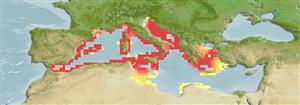Common names from other countries
Classification / Names / Names
ชื่อสามัญ | ชื่อพ้อง | Catalog of Fishes (gen., sp.) | ITIS | CoL | WoRMS
Environment: milieu / climate zone / depth range / distribution range
นิเวศวิทยา
; ระดับความลึก 10 - 1016 m (Ref. 66603), usually 10 - 100 m (Ref. 358). Subtropical
Eastern Atlantic and the Mediterranean.
Length at first maturity / ขนาด / น้ำหนัก / Age
Maturity: Lm ? range ? - ? cm Max length : 3.0 cm COLD เพศผู้/กระเทย; (Ref. 363)
Arborescent colonies, with growth irregularly divided into all directions, provided with a Hard skeleton calcareous: can exceed 50 cm, but in general less developed. The surface of the ramifications is not smooth. Polyp: reach the diameter of 0.15 cm; they are white and translucent, the cortical fabric being of red color, seldom white or yellow. The skeleton is highly colored of red; more rarely of pink; dark; white red or to black (Ref. 358). Certain colonies: 20 cm height, but intensive fishing makes disappear the largest specimens. Diameter of the base: 3 cm at the largest specimens (Ref. 363).
Hard skeleton calcareous: can exceed 50 cm, but in general less developed. Polyp: reach the diameter of 0.15 cm. Depth: commonly 10 m of depth; currently, it is necessary to go down beyond the 30 m, generally even 40 m, and until several hundred meters of depth (Ref. 358). Maximum depth and common maximum depth from Ref. 122525. Habitat: Found in the infra- and circalittoral zones as well as bathyal zones (Ref. 85338). Sites little exposed to the solar rays: lower level of rock overhangs, anfractuosities and excavations, rock walls located at great depth (Ref. 358); conditioned by two essential criteria: the weak luminosity and the substrate. One finds it in theory only on the bed rock under conditions of reduced illumination. At the surface levels, it characterizes the biocenoses semi-obscure caves. Low, one meets it on rock cliffs or sproutings. Harvests, made more and more deeply, restrict its bathymetric distribution. (Ref. 363). Found on cave walls, vertical cliffs and overhangs (Ref. 66603). Exposure to high temperatures beyond 24°C appears to have a critical mortality effect, decreasing polyp activity and calcification rates (Ref. 129072).
Life cycle and mating behavior
วัยเจริญพันธุ์ | การสืบพันธุ์ | การวางไข่ | เซลสืบพันธ์ของเพศเมีย(ไข่) | ความดกของไข่ | ตัวอ่อน
Members of the class Anthozoa are either gonochoric or hermaphroditic. Mature gametes are shed into the coelenteron and spawned through the mouth. Life cycle: The zygote develops into a planktonic planula larva. Metamorphosis begins with early morphogenesis of tentacles, septa and pharynx before larval settlement on the aboral end.
Göthel, H. 1992. (Ref. 358)
IUCN Red List Status (Ref. 130435)
CITES status (Ref. 108899)
Not Evaluated
Not Evaluated
Human uses
การประมง: การค้า
FAO - การประมง: landings, species profile | FishSource | ทะเลรอบๆเรา
เครื่องมือ
แหล่งที่มาจากอินเตอร์เน็ต
Estimates based on models
Preferred temperature
(Ref.
115969): 13.8 - 19.6, mean 17.7 (based on 240 cells).
ความสามารถในการกลับคืนสู่ปกติ
ต่ำ, เวลาต่ำสุดที่จะทำให้ประชากรเพิ่มขึ้นเป็น 2 เท่าใช้เวลา 4.5 - 14 ปี (K=0.06).
Price category
Unknown.
